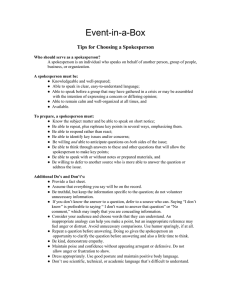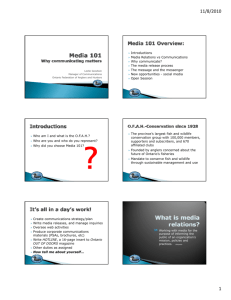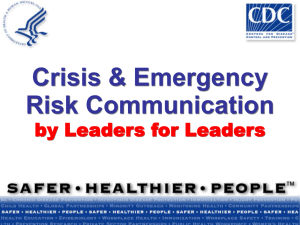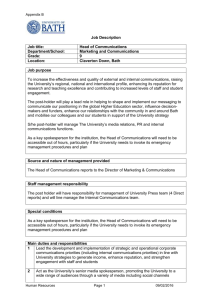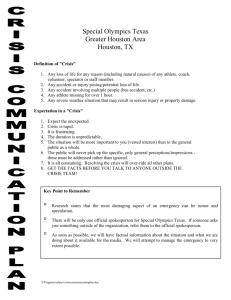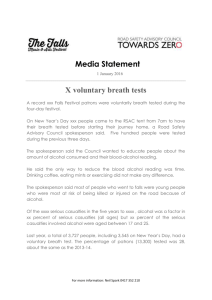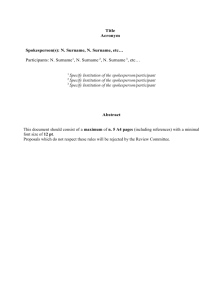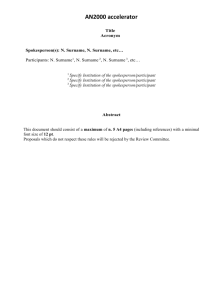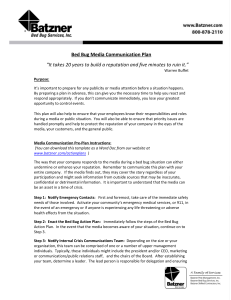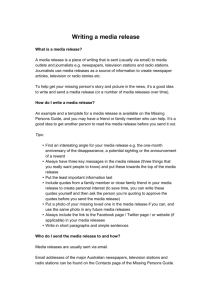Communicating in a Crisis Is Different
advertisement
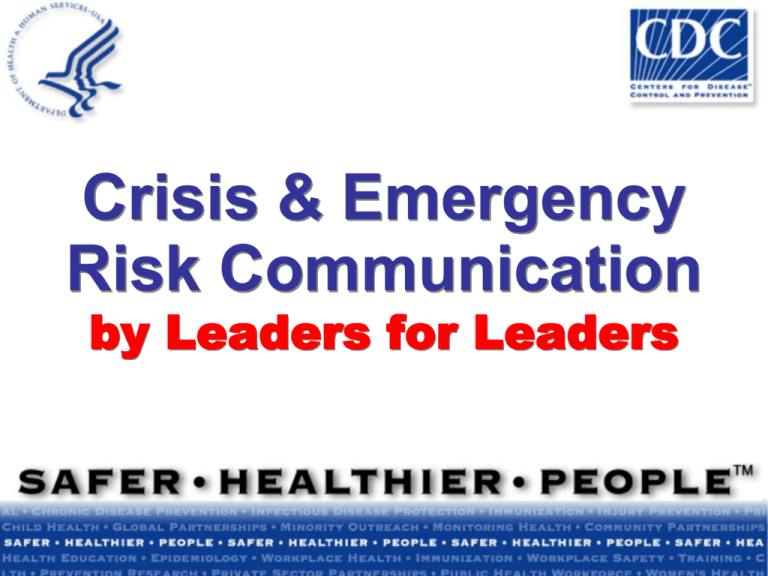
Crisis & Emergency Risk Communication by Leaders for Leaders Communicating in a crisis is different In a serious crisis, all affected people . . . – Take in information differently – Process information differently – Act on information differently Be FIRST… Be RIGHT… Be CREDIBLE… Yes, leaders communicate, and In a catastrophic event, your . . . – every word, – every eye twitch, – every passing emotion . . . resonates with heightened importance to the public The Risk of Disasters Is Increasing Increased terrorism Population density Aging U.S. population International travel speed Emerging diseases What the public seeks from your communication 5 public concerns. . . 1. Gain wanted facts 2. Empower decisionmaking 3. Involved as a participant, not spectator 4. Provide watchguard over resource allocation 5. Recover or preserve well-being and normalcy Crisis and Emergency Risk Communication impacts 5 organizational concerns -- you need to. . . 1. Execute response and recovery efforts 2. Decrease illness, injury, and deaths 3. Avoid misallocation of limited resources 4. Reduce rumors surrounding recovery 5. Avoid wasting resources 5 communication failures that kill operational success 1. 2. 3. 4. 5. Mixed messages from multiple experts Information released late Paternalistic attitudes Not countering rumors and myths in real-time Public power struggles and confusion 5 communication steps that boost operational success 1. 2. 3. 4. 5. Execute a solid communication plan Be the first source for information Express empathy early Show competence and expertise Remain honest and open The STARCC Principle Your public messages in a crisis must be: Simple Timely Accurate Relevant Credible Consistent Psychology of a Crisis What Do People Feel Inside When a Disaster Looms or Occurs? Psychological barriers: 1. Fear, anxiety, confusion, dread 2. Hopelessness or helplessness 3. Seldom panic 4. Fight or flight 5. Vicarious rehearsal What Is Vicarious Rehearsal? The communication age gives national audiences the experience of local crises. These “armchair victims” mentally rehearse recommended courses of actions. Recommendations are easier to reject the farther removed the audience is from real threat. Individuals at risk—the cost? Dependence on special relationships MUPS—Multiple Unexplained Physical Symptoms Self-destructive behaviors Stigmatization Communicating in a Crisis Is Different Uncertainty is greatest concern for most Reduce anxiety-Give people things to do Public seeks restored self-control Public must feel empowered – reduce fear and victimization Decisionmaking in a Crisis Is Different People simplify Cling to current beliefs We remember what we see or previously experience (first messages carry more weight) People limit intake of new information (3-7 bits) How Do We Communicate About Risk in an Emergency? All risks are not accepted equally Voluntary vs. involuntary Controlled personally vs. controlled by others Familiar vs. exotic Natural vs. manmade Reversible vs. permanent Statistical vs. anecdotal Fairly vs. unfairly distributed Affecting adults vs. affecting children Messages and Audiences What the Public Will Ask First Are my family and I safe? What have you found that may affect me? What can I do to protect myself and my family? Who caused this? Can you fix it? What the Media Will Ask First What happened? Who is in charge? Has this been contained? Are victims being helped? What can we expect? What should we do? Why did this happen? Did you have forewarning? Public Information Release What to release When to release How to release Where to release Who to release Why release Judging the Message Speed counts – marker for preparedness Facts – consistency is vital Trusted source – can’t fake these 5 Key Elements To Build Trust 1. 2. 3. 4. 5. Expressed empathy Competence Honesty Commitment Accountability Initial Message Must Be short Be relevant Give positive action steps Be repeated Initial Message Must Not Use jargon Be judgmental Make promises that can’t be kept Include humor Working With the Media What is news? Change or controversy Black or white, not gray Crises or opportunities Entertain versus inform Individual versus group/officials Disasters Are Media Events We need the media to be there. Give important protective actions for the public. Know how to reach their audiences and what their audiences need. How To Work With Reporters Reporters want a front seat to the action and all information NOW. Preparation will save relationships. If you don’t have the facts, tell them the process. Reality Check: 70,000 media outlets in U.S. Media cover the news 24/7. Information sought by media Casualty numbers, condition, treatment Property damage Response and relief activities Resulting effects (anxiety, stress) Questions are predictable Media and Crisis Coverage Evidence strongly suggests that coverage is more factual when reporters have more information. They become more interpretative when they have less information. What should we conclude? Command Post Media will expect a command post. Official channels that work well will discourage reliance on nonofficial channels. Be media-friendly at the command post— prepare for them to be on site. Media Availability or Press Conferences “In Person” Tips Determine in advance who will answer questions about specific subject matters Assume that every mike is “alive” the entire time Sitting or standing? Writing for the Media During a Crisis The pressure will be tremendous from all quarters. It must be fast and accurate. It’s like cooking a turkey when people are starving. If information isn’t finalized, explain the process. Role of a Spokesperson in an Emergency Take your organization from an “it” to a “we” Remove the psychological barriers within the audience Ultimately, reduce the incidence of illness, injury, and death by getting it right Spokesperson Qualities What makes a good spokesperson? What doesn’t make a good spokesperson? How to be a great spokesperson after 5 minutes of training! Great Spokesperson Step 1 It’s more than “acting natural.” Every organization has an identity. Try to embody that identity. Example: CDC has a history of going into harm’s way to help people. We humbly go where we are asked. We value our partners and won’t steal the show. Therefore, a spokesperson would express a desire to help, show courage, and express the value of partners. “Committed but not showy.” Emergency Risk Communication Principles Don’t overreassure Acknowledge that there is a process in place Express wishes Give people things to do Ask more of people Emergency Risk Communication Principles Consider the “what if” questions. Spokesperson Recommendations Stay within the scope of your responsibility Tell the truth Follow up on issues Expect criticism Stakeholder/ Partner Communication Stakeholder/Partner Communication Stakeholders have a special connection to you and your involvement in the emergency. They are interested in how the incident will impact them. Partners have a working relationship to you and collaborate in an official capacity on the emergency issue or other issues. They are interested in fulfilling their role in the incident and staying informed. 5 Mistakes With Stakeholders Inadequate access Lack of clarity No energy for response Too little, too late Perception of arrogance Stakeholders can be . . . Advocate–maintain loyalty Adversary–discourage negative action Ambivalent–keep neutral or move to advocate Contact: Trisha Steiniger Assistant Vice President, Information & Referral 2-1-1 Director United Way of Greater Richmond & Petersburg 2001 Maywill Street; P.O. Box 11807 Richmond, VA 23230 phone: 804-225-7916; fax: 804-225-7913
![Crisis Communication[1] - NorthSky Nonprofit Network](http://s2.studylib.net/store/data/005428035_1-f9c5506cadfb4c60d93c8edcbd9d55bf-300x300.png)
